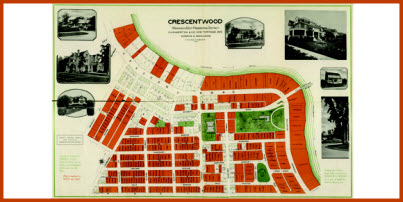by Bruce Cherney (part 5 of 5)
Crescentwood Park (now Enderton Park and commonly referred to as “Peanut Park”) was dedicated to the city in 1902, “provided your (parks) board will agree to improve the same and keep it in proper condition as a public park. In order that there should be no misunderstanding, I would require that, as soon as possible, next year, the park be laid out and fenced and trees and shrubs planted in order that the same may be growing and that it be improved from time to time in the harmony with the development and improvements of the abutting property.”
Originally, the city was reluctant to accept the park from Charles Henry “C.H.” Enderton, according to the September 8, 1917, Tribune, since Crescentwood in 1902 “was but a mere stretch of brush land, and it was difficult for the authorities to appreciate the advisability of establishing a park in this section.”
But eventually, the city did accept, and by 1917, “325 beautiful homes, aggregating in cost nearly five million dollars, now surround this park.”
At the time, it was called one of the city’s most beautiful parks, but the passage of time took its toll.
In 2006, when Enderton Park needed to be spruced-up after years of neglect, local residents raised $250,000, with the help of the city and Manitoba Hydro, for landscaping, a playground and benches that were based on early photographs.
Enderton’s association with a real estate company didn’t end with his death in 1920. Instead, the company using his name was taken over by Clarence Day Shepard, who was an early associate of Enderton, beginning in 1902.
The Tribune of September 8, 1949, reported that Shepard had died at the age of 78. At the time of his death, Shepard was the president of C.H. Enderton & Co., real estate brokers, 222 Portage Ave. He had also been a president of the Winnipeg Real Estate Exchange (today’s WinnipegREALTORS®).
Peter Rattray was the president of C.H. Enderton & Co. in the last 20 years of the firm’s existence. He retired from the company in 1987 and passed away in 2004.
A number of the original stately homes in Crescentwood remain, but many have been demolished (an estimate in 1997 was that 36 were torn down) in the aftermath of the Great Depression and the Second World War, although replacement construction continued after the war.
The structures were architecturally diverse, offered a wide range of styles and ornamental treatment, and were nestled amongst large trees and heavily landscaped lawns (City of Winnipeg Historical Buildings Committee, May 1991).
One home demolished during the Great Depression was that of Sir Daniel McMillan, at 645 Wellington Cres., which was completed in 1912. In May 1933, an auction sale was held of the home’s contents. The final item to be bid on was a great Khabistan carpet, 20-by-14 feet, with more than 440 hand-tied knots per square inch, reputed to be worth over $35,000, but only netted less than $2,000 (Stories House Tell, February 13, 1937, Winnipeg Tribune article, by Lillian Gibbons).
The McMillan home was demolished in 1937.
Among the homes along the riverbank that were torn down were those of Isaac Pitbaldo, a prominent lawyer, and William H. Carter, a contractor and later chief commissioner of Winnipeg Transit.
Other houses no longer existing were owned by Sidney T. Smith, president of Reliance Grain Co., Lt.-Col. Hugh F. Osler, president of Osler, Hammond and Nanton, and the home of George F. Galt, president of Blue Ribbon Ltd., at 460 Wellington Cres. James Stewart bought the home, built in 1912, for $100,000 just after the death of Galt in 1928.
“The house where the Prince of Wales danced,” was the name given to the Galt mansion. On the evening of October 11, 1924, the Prince of Wales, arrived at the mansion, “and as usual displayed gentle winning courtesy of manner, gracious openess, and absence of reserve,” dancing with hostess Mrs. Galt and four others ladies from the neighbourhood (Stories Houses Tell, Winnipeg Tribune article, by Lillian Gibbons, January 7, 1956).
The home was demolished in 1956.
The original Munson home, called Crescentwood and located at 475 Wellington Cres., was the first residence erected in the area. It was built by John Henry Dumble Munson in 1889, the founder of the law firm Munson, Allan, Laird & Davis. Munson was born in Cobourg, Ontario, in 1859 and came to Winnipeg in 1881. He died at his Wellington Crescent home on February 8, 1918.
The Munson mansion, built on 4.45 acres of land, was bought in 1919 and renovated by the James Richardson family. It was demolished in 1980. The property was then donated by the Richardson family to the city and is now the site of Munson Park. To complete the park, the city purchased 0.78 acres to the west, which allowed for the inclusion of another 1.15 acres of Richardson property and a total area for the park of 6.23 acres.
This Old House named Crescentwood as one of the Best Old House Neighborhoods 2013: Family-Friendly in the U.S. and Canada that “offer great schools, ample playgrounds and parks, and safe streets.”
“Today, Crescentwood’s century-old streets are lined with towering century-old oak trees, and residents have put great care into restoring their homes, says resident Barbara Parke, who has lived in the area since 1975.”
According to the article, “You won’t find many bargains or fixer-uppers, but for what you’ll pay, you’ll get a large house that is full of original details inside and out.”



